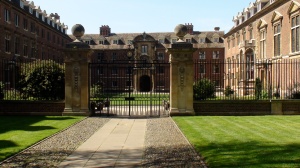Stop #1: The Conservatory
 So that’s how a banana grows? The first bunch really took me by surprise, but the second, larger one looked more like what I’m used to, sitting green on the produce counter. Only it still looks upside down. Seeing the bananas on the tree is only slightly less revelatory to me than when I learned last month that asparagus grows in single stalks right out of the dirt, like a bunch of dead guy’s fingers.
So that’s how a banana grows? The first bunch really took me by surprise, but the second, larger one looked more like what I’m used to, sitting green on the produce counter. Only it still looks upside down. Seeing the bananas on the tree is only slightly less revelatory to me than when I learned last month that asparagus grows in single stalks right out of the dirt, like a bunch of dead guy’s fingers.
I don’t necessarily like agrarian metaphors for education—though they are markedly less offensive than ones out of medicine or business—but I can’t help comparing what I’m thinking right now, seeing what that bunch of bananas looks like in process—to what it’s been like over the past 10 years learning how little humans acquire language and learn to represent their speech and thoughts through writing.
As a grown-up who taught almost-grown-ups for so long, that developmental mystery and miracle was hidden to me. It’s so much easier to appreciate the work adolescent writers do when you have even some understanding of what they went through to get there.
And I much prefer to think of kids as that bunch of bananas, growing together even if upside down, than as those lonely asparaguses.
Stop #2: The Idea Garden, but still inspired by the Conservatory
 I have not thought of hens and chicks (properly called sempre vivum) for over thirty years. The only other place I can remember seeing or hearing about them was in my grandma’s yard, growing in a few pots in front of her house on Cleveland Ave. in Rochelle, Illinois.
I have not thought of hens and chicks (properly called sempre vivum) for over thirty years. The only other place I can remember seeing or hearing about them was in my grandma’s yard, growing in a few pots in front of her house on Cleveland Ave. in Rochelle, Illinois.
The back yard adjoined the far end of a golf course, though at that age all I knew of golf was the occasional ball that made its way near the chain link fence. Much more memorable was the ancient Carmen’s shingled doghouse, which I would climb atop like Snoopy and Woodstock did. Side note: I would find Carmen’s sun-baked poop and think it came out hard and white. Just like her.
Across the front yard was Connoly Park, which featured a gate mounted to a pole, made to swing around on. I also remember banks of snow piled high, reaching up past her large front window. I’m pretty sure I’m really just remembering a photograph.
And visiting in my new brown winter coat, with a hood and football patch, being pleased that she said I looked like a teddy bear. I had no idea what a heart attack was, but I knew that’s why we were there, on such short notice and so late at night.
Stop #3: Caffe Paradiso
Cafe culture is bizarre to me, kind of appealing, the idea of habitually sitting and talking and reading and writing. Sounding a little like the Summer Institute now that I put it into words.
But I feel culturally conditioned to think there’s something wrong with this. Shouldn’t everyone be somewhere, somewhere else, like working?
I’m horrible at relaxing. The idea of a few unstructured days without any tasks due or deadlines looming kind of terrorizes me. This, I realize, is a me problem. I do better when I’m with my son; I can throw a football or swim for an hour. But there I still feel like I’m getting something done, being with him and “doing parenting.”
Am I being too honest about this neurosis?
My favorite vacations are to cities, where the pace picks up and there’s more to do. A week at a beach and I have no idea what to do. The beachiest I get is a day at Coney Island, with its Russian immigrant retiree sunbathers and beaches that are at least as much broken glass as they are sand … and a thirty minute ride on the Q train back to the city.



